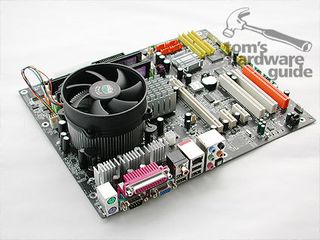Intel Stakes Its Vision of the PC Future with 775 Launch
915G Express Chipset, Continued

Our 915G testbed system, based on the MSI 915P Neo2.
As with all integrated graphics solutions, however, accessing the system memory has very negative effects on 3D performance, since the bandwidth is very low compared to the memory, together with bus width, used on modern graphics cards. Integrated graphics solutions just barely manage to attain the performance of low-cost entry-level graphics cards. A data rate of 8.6 GB/s, which is possible with DDR2 533 memory, doesn't sound bad at first, but this bandwidth has to be shared with all other components in the system as well.
Intel positions the GMA 900 as a real alternative for mainstream graphics cards. Here, Intel bases its definition of "mainstream" on the current figures of overall sold graphics units, rather than the classification of graphics cards, which is what users have come to expect from 3D graphics card manufacturers. "Mainstream" thus refers to individual 3D graphics cards that fall within the $40-$50 range, are of the Radeon 9200 and GeForce FX 5200 class with 64 bit memory interface, and whose 3D performance is less than mediocre, to put it mildly.
Despite DirectX 9 support, the integrated graphics in Intel 915G is everything but an alternative for PC gamers. Instead, Intel targets office users who only occasionally want to play computer games, and it's here that GMA 900 can really score. For one thing, its additional power consumption remains within single-digit wattage figures, while that of external graphics solutions soar up to two and three-digit figures. In addition, the GMA 900 can be passively cooled, the 2D image quality on our test system was very good. For DVI output, Intel is offers a SVDO daughter card for the x16 PCI Express slot. It's unknown if Intel can provide dual-view CRT support by this kind of technique too.

This strange fellow is a Silicon Image 1364ADD2 SVDO card for digital video out, based on the Sil 1364 DVI transmitter chip.
Stay on the Cutting Edge
Join the experts who read Tom's Hardware for the inside track on enthusiast PC tech news — and have for over 25 years. We'll send breaking news and in-depth reviews of CPUs, GPUs, AI, maker hardware and more straight to your inbox.
Current page: 915G Express Chipset, Continued
Prev Page 915G Express Chipset Next Page 915G Express Chipset, ContinuedMost Popular

